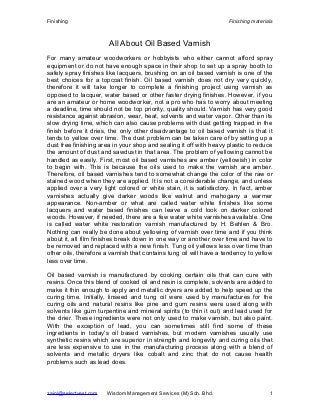
Finishing materials
- 1. Finishing Finishing materials All About Oil Based Varnish For many amateur woodworkers or hobbyists who either cannot afford spray equipment or do not have enough space in their shop to set up a spray booth to safely spray finishes like lacquers, brushing on an oil based varnish is one of the best choices for a topcoat finish. Oil based varnish does not dry very quickly, therefore it will take longer to complete a finishing project using varnish as opposed to lacquer, water based or other faster drying finishes. However, if you are an amateur or home woodworker, not a pro who has to worry about meeting a deadline, time should not be top priority, quality should. Varnish has very good resistance against abrasion, wear, heat, solvents and water vapor. Other than its slow drying time, which can also cause problems with dust getting trapped in the finish before it dries, the only other disadvantage to oil based varnish is that it tends to yellow over time. The dust problem can be taken care of by setting up a dust free finishing area in your shop and sealing it off with heavy plastic to reduce the amount of dust and sawdust in that area. The problem of yellowing cannot be handled as easily. First, most oil based varnishes are amber (yellowish) in color to begin with. This is because the oils used to make the varnish are amber. Therefore, oil based varnishes tend to somewhat change the color of the raw or stained wood when they are applied. It is not a considerable change, and unless applied over a very light colored or white stain, it is satisfactory. In fact, amber varnishes actually give darker woods like walnut and mahogany a warmer appearance. Non-amber or what are called water white finishes like some lacquers and water based finishes can leave a cold look on darker colored woods. However, if needed, there are a few water white varnishes available. One is called water white restoration varnish manufactured by H. Behlen & Bro. Nothing can really be done about yellowing of varnish over time and if you think about it, all film finishes break down in one way or another over time and have to be removed and replaced with a new finish. Tung oil yellows less over time than other oils, therefore a varnish that contains tung oil will have a tendency to yellow less over time. Oil based varnish is manufactured by cooking certain oils that can cure with resins. Once this blend of cooked oil and resin is complete, solvents are added to make it thin enough to apply and metallic dryers are added to help speed up the curing time. Initially, linseed and tung oil were used by manufactures for the curing oils and natural resins like pine and gum resins were used along with solvents like gum turpentine and mineral spirits (to thin it out) and lead used for the drier. These ingredients were not only used to make varnish, but also paint. With the exception of lead, you can sometimes still find some of these ingredients in today's oil based varnishes, but modern varnishes usually use synthetic resins which are superior in strength and longevity and curing oils that are less expensive to use in the manufacturing process along with a blend of solvents and metallic dryers like cobalt and zinc that do not cause health problems such as lead does. zaini@selectvest.com Wisdom Management Services (M) Sdn. Bhd. 1
